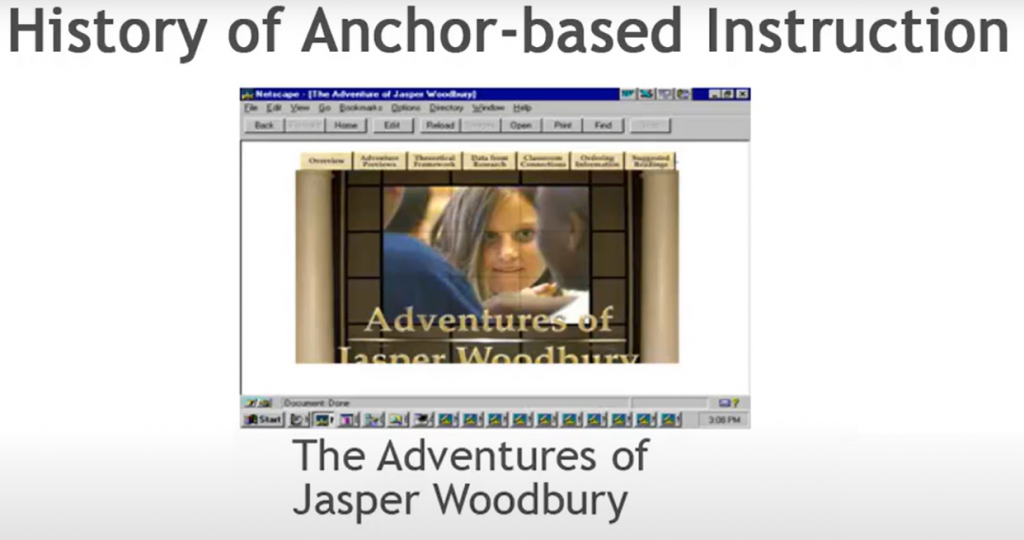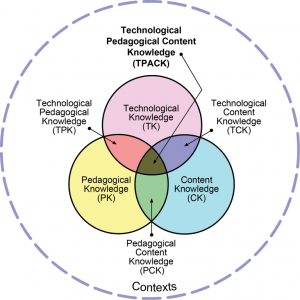The Adventures of Jasper Woodbury
(a.k.a. The Jasper Series)

The Jasper Series is a math multi-media education project consisting of 12 digital videos that targets students at grade 5 and higher. The project was developed by a group of researchers from the Cognition and Technology Group at Vanderbilt University between the late 1980’s and mid 1990’s to promote students’ interest in and ability with solving mathematical problems and engaging in mathematical thinking. The videos revolve around Jasper Woodbury and relay stories in context rich, authentic, problem-posing scenarios that are designed to engage students in mathematical problem solving and reasoning. The challenges also aim to support student communication and collaboration and provide interdisciplinary connects to other subject areas.
Constructivist and TPACK Underpinnings
The Jasper Series is formulated around a constructivist learning theory, which posits that both prior and experiential learning, combined with opportunities to develop thinking through process of exploration, investigation, reasoning, justification, and reflection, is a requirement of learning (Cobb, 2005; Fosnot & Perry, 2013; Posner et al., 1982; and Von Glaserfeld, 2005). The Jasper video stories are situated in real-world events with real-world challenges and include multiple forms of connected information. The use of a content-rich context to situate and develop diverse problem-solving solutions is a strategy known as anchored instruction (AI). The pedagogical strategy has connections to case-based learning (Hallinger, Leithwood, & Murphy, 1993, as cited in UBC ETEC533, n.d.), problem-based learning (Duffy, Lowyck, & Jonassen, 1993, as cited in UBC ETEC533, n.d.) and project-based learning (Dewey, 1933, as cited in UBC ETEC533, n.d.). These constructivist strategies highlight authentic, situated, collaborative learning problems as a means to facilitate learning that is more meaningful, memorable, and transferable.
Teacher Questions on Anchored Instruction
I accept the constructivist premises outlined above, and as I consider embedding AI in my practice, I have the following questions:
- Given a well-developed anchor activity, how could I use it to as a starting point for further customization?
- What contexts would adult learners in a foundational course find most engaging?
- What are the advantages and disadvantages of giving different student groups slightly different contextualizations?
- What modification strategies are recommended for anchor activities when dealing with various learner characteristics and needs? For example, ELL students, students with poor mathematical self-efficacy beliefs, students with weak prior knowledge and/or application skills?
- What emphasis in graded assessment of anchored activities is appropriate?
- What would a rubric for an anchored activity assessment include? Is there a starting example that can be customized?
- Can artificial intelligence tools be used to support the implementation of anchored instruction? For example, can artificial intelligence tools assist with activity customizations and student support?
References
Cobb, P., (2005). Chapter 3: Where is the mind? A coordination of sociocultural ad cognitive constructivist perspectives. In C. T. Fosnot (Ed.), Constructivism: Theory, perspectives, and practice, (2nd ed., pp. 39-57). Teachers College Press.
Fosnot, C. & Perry, R. S. (2013). Chapter 2: Constructivism: A Psychological theory of learning. In C. T. Fosnot (Ed.), Constructivism: Theory, perspectives, and practice, (2nd ed., pp. 8-38). Teachers College Press.
Gronseth, S. (2015, November 12). Constructivist approaches [Video]. The University of Houston. https://www.youtube.com/watch?v=krqjqGIuC-A
Koehler, M. (2011, May 11). Using the TPACK image. TPACK Org. https://matt-koehler.com/tpack2/using-the-tpack-image/
Posner, G. J., Strike, K. A., Hewson, P. W. and Gertzog, W. A. (1982). Accommodation of a scientific conception: Toward a theory of conceptual change. Science Education, 66: 211–227. doi: 10.1002/sce.373066020
UBC ETEC533. (n.d.). Lesson 1: The Jasper Project. University of British Columbia. Retrieved from https://learning.edge.edx.org/course/course-v1:UBC+ETEC533-65A+2022W2/block-v1:UBC+ETEC533-65A+2022W2+type@sequential+block@51113f4c02184ecdacf47e7c47a0a622/block-v1:UBC+ETEC533-65A+2022W2+type@vertical+block@d90e562b36294469b5a5ddbadffe9f1d on February 17, 2023.
Van, S. (2017, February 15). Anchored instruction educational model: Model research presentation [Video]. The University of Memphis. https://www.youtube.com/watch?v=3xOTvc_dKUg
Von Glaserfeld, E. (2005). Introduction: Aspects of constructivism. In C. T. Fosnot (Ed.), Constructivism: Theory, perspectives, and practice (2nd ed., pp, 3-7). Teachers College Press.


